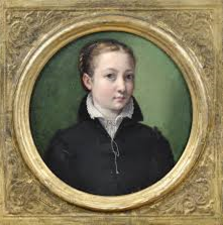
This essay is based on my research on Italian Renaissance painter Sofonisba Anguissola, who is the protagonist in my novel (in progress), An Illustrious Woman.
NUANCES OF SHADE: Sofonisba Anguissola and her Art
Placing her in Context
By: Monica E. Spence
There are men and women who put their stamp on a particular subject because of their work: Sofonisba Anguissola is one such woman. Sofie watched Michelangelo’s muscular Mannerist style of the late Renaissance transform into the intricate, decorative style of Van Dyck’s Baroque period[1]. Each style blended into the other, and yet was visually, subjectively and contextually different from the styles established since the Thirteenth Century by Cimabue and Giotto.
A pioneer in the art of realistic portraiture, Sofie did what few other painters had ever done— she single-handedly introduced two sub-genres of painting. In 1555, The Chess Game(Illustration 1), her quadruple portrait of three of her sisters playing chess while their servant looks on from the side of the canvas, shows liveliness and glee ever before seen in paintings.[2] During the 1570s, she painted a Portrait of a Lady wearing a ropa[3] or zimarra[4] with gold embroidery and holding a vase of flowers (Illustration 2). It was one of the first 16th Century paintings to combine a still life with a portrait.[5]
In Sofie’s long series of self-portraits, she consistently shows herself to be a woman of serious demeanor[6] (Illustration 3). In more than one of her early self-portraits, she proudly announces herself as a virgin, the state regarded at the time as a woman’s only possession of worth. The Council of Trent (1545- 1564) restated, “…virginity was still a more blessed state than marriage.”[7] In her art Sofie surrounds herself with the trappings a well-educated woman who is skilled in many of the Arts: painting (Illustration 4), music (Illustration 5), and reading and learning (Illustration 6). In her self-portraits, her clothing is unusually subdued for a lady of her rank: she is usually seen wearing a black doublet (sleeveless jacket) over a brown or dark plum gown, her white chemise (blouse) peeking from her sleeves and neckline, her hair braided about her head and encased in a black snood, and wearing no jewelry. She is a study of a virtuous and studious young woman of the Renaissance.
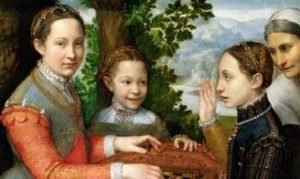
The Chess Game
c.1555
Sofonisba Anguissola
Poland:
Museum Narodowe

Portrait of a Lady
c.1570
Sofonisba Anguissola
St. Petersburg: Hermitage
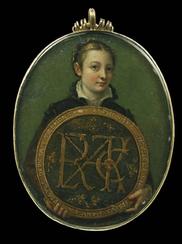
Self-Portrait in Miniature
(c.1556)
Sofonisba Anguissola
Boston: Museum of Fine Arts
Inscribed: Sophonisba Anguissola Vir(go) IpshusManuex (s)peculoDepictum Cremona. (Sophonisba Anguissola, Maiden, painted this by using a mirror.) Note that she has spelled her name in the manner of Hannibal’s Carthaginian niece.

Sofonisba Anguissola (1556)
Self-portrait at an Easel
Lancut: Museum Zamek
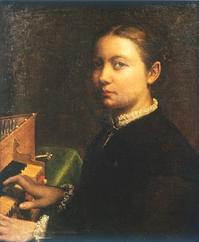
Sofonisba Anguissola
Self-portrait playing the Clavichord (1556-57)
Naples: Museo di Capodimonte
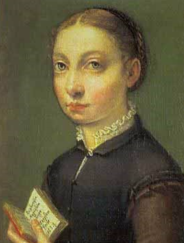
Sofonisba Anguissola (1554)
Self-portrait with a Book, with Detail
Vienna: Kunsthistorisches Museum
Detail: The book is inscribed:
Sofonisba Anguissola Virgo seipsamfecit, 1554
(Sofonisba Anguissola, Maiden, painted this herself, 1554.)
As a woman, and especially as a noblewoman, Sofie could not legally apprentice to a master artist, join a guild or learn anatomy through dissection. She could not sketch nude male models. The paternalistic concepts of sheltering and protecting women from the unpleasantness of life prevented her from gaining the primary knowledge she needed to succeed. Forced to use her family and friends as her live models, she flourished as a painter by employing the resources available to her. By employing household situations and familiar, beloved subjects, Sofie gained a sense of intimacy and genuine warmth of real people in her work, moving them far from the traditional stiff formality of the portrait of her era. She infused an obvious joy in her paintings, giving the viewer a feeling that s/he “knows” the people in the painting. The observer can identify with the situation in the scene being portrayed. The people in the painting may be strangers to the viewer, but their poses and their smiles are instantaneous and familiar. No wonder Sofonisba Anguissola is called the “The Smile Maker.”[8]
At the time, there was no term for Sofonisba’s style of painting, because it was she who invented the style, later called domestic genre painting. For example, in The Chess Game (1555) (Illustration 1), and in her unfinished, though intimate, family grouping entitled Amilcare, Astrubale, and Minerva Anguissola (1557-58) (Illustration 7), where Sofie portrayed her gray-bearded father, her little brother and her middle sister, the viewer can see critical differences, both stylistically and of content, when compared with her contemporaries.
In Lorenzo Lotto’s Family Portrait of Signore Giovanni de la Volta, his Wife and their Children (Illustration 8), is Lotto’s only known family grouping. We see frozen figures with little or no interaction among them. The setting is similar in several ways to The Chess Game. In each, the richly dressed figures are placed around Oriental carpet-draped tables, and identifiable backgrounds lay beyond the sitters.
In Lotto’s work, the children are grasping at cherries. Called the Fruit of Paradise, cherries symbolize the sweetness of character derived from good works.[9] The stiffly posed parents stare at the spectator with the blankest of expressions and have no real physical contact with these young children. Looking at the adults’ eyes, they appear soulless and strangely removed from the actions of their children, who may soon be in danger from choking on the pits of the cherries. No one in the painting is actually looking directly at another person; the children are focused on the fruit, while the parents gaze expressionlessly at the viewer. One wonders why there is so is little warmth or family feeling exhibited. Lotto was a fully mature artist at the time and Sofonisba Anguissola was at the start of her career, yet Sofie’s treatment of action, tenderness, and sensitivity in her group portraits are rarely shown by even the great Masters of her era. Her work is active, not static.
Giovanni Battista Moroni’s A Gentleman and his two Children (Illustration 9), gives us another family grouping.[10] While the pose is fixed, there is more warmth and affection. While the father shelters his children protectively in his arms, the artist has not provided any action in the picture, either in the stance or the children’s response to their father holding them. The picture looks more like a photograph, where the photographer orders his clients to: “say cheese,” and everyone freezes in place. The books on the shelf in the background and on the table where Signore Zuane rests his elbow, indicates the family, or at least the father, values learning. The apple, held by the younger child[11] is a symbol most usually seen as an allusion to Original Sin and the Fall of Man, but I pose that here the reference is most likely to The Bible, specifically Deuteronomy 32.10[12], and Psalms 17.8[13].
In his second edition of his seminal work on Art History, Lives of Painters, Sculptors, and Architects[14], Giorgio Vasari described both The Chess Game and Amilcare, Astrubale, and Minerva Anguissola. In 1566, he made an impromptu journey from Florence to Cremona to meet Sofie but discovered she had already departed Italy for Spain and the Court of Philip II. Sofie’s parents welcomed the unexpected visitor and showed him their eldest daughter’s paintings, as well as those of Lucia (who had died in 1565) and Europa. Vasari marveled at the brilliance and lifelike qualities of Sofie’s paintings by saying they were “…done with such care and such spirit that they have all the appearance of life, and are wanting in nothing save speech.”[15]
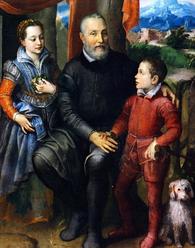
Sofonisba Anguissola (1557-58)
Amilcare, Astrubale, and Minerva Anguissola
Niva, Denmark: Nivaagaards Malerisaamling
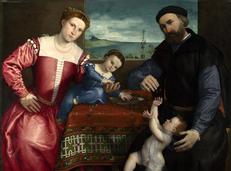
Lorenzo Lotto (1547)
Family Portrait: Signore Zuane de la Volta, his Wife and their Children,
London: National Gallery
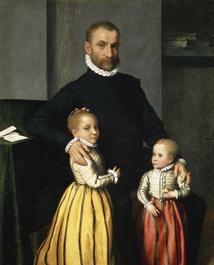
Giovanni Battista Moroni (1565)
A Gentleman and his two Children
Dublin: National Gallery of Ireland
Vasari concludes his praise of Sofie and her sisters saying: “…If women know so well how to produce living men, what marvel is it that those who wish are also so well able to create them in painting?”[16]
A century after The Chess Game was painted, the great Dutch artist Johannes Vermeer would be the principal artist to take up Sofie’s mantle as a domestic genre painter (Illustration 10). Unfortunately, between 1625, the time of Sofie’s death, and the 1995 exhibit of her paintings, critics appreciated the technical skills (diligenza[17]) behind the paintings, but all too frequently reattributed her works to male painters.[18]

Johannes Vermeer (1658-1660)
A Glass of Wine
Berlin: Galerie Dahlem
In old age, Sofie suffered from debilitating cataracts, which prevented her from painting, though she was not totally blind. When Antony Van Dyck visited her in July 1624, he sketched and wrote in his Italian Diary (Illustration 11) concerning his visit.[19]
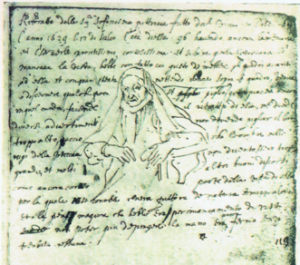
Antony Van Dyck (1624)
The Italian Sketchbook: Sofonisba Anguissola
London, England: British Museum
“…portrait of the aged painter Signora Sofonisba, done from life in Palermo in the year 1624, on 12 July: her age being 96 years, still with her memory and brain most quick, and most kind, and although she has lost her sight because of old age, she enjoyed to have paintings put in front of her, and with great effort by placing her nose close to the picture, she could make out a little of it and took great pleasure in that. As I was doing her portrait, she gave me various recommendations, of not to take the light too high, so that the shadows in the wrinkles of old age should not be too strong, and many other good suggestions. And she also told me part of the story of her life, from which I learnt that she was a painter of nature and a miraculous one and her greatest misfortune was that she could not paint any longer because of her lack of eyesight: even though her hand was still firm and had no tremor whatsoever.”[20]
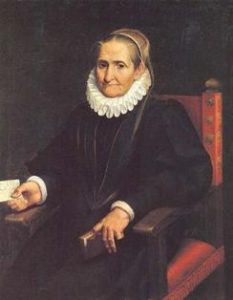
Sofonisba Anguissola (1610)
Self-portrait
Bern, Switzerland: Gottfried Keller Collection
Inscription on the letter:
Alla Mag(esta) Catolica besa la m(ano), Anguissola.
(To his Catholic Majesty, I kiss your hand. Anguissola)
Sofonisba Anguissola was a student of Michelangelo’s[21] and a tutor of Sir Antony Van Dyck.[22] Childless, she died at the age of ninety-three (or ninety-six, according to Van Dyck) of the plague[23] that had ravaged so much of the landscape of Europe during the Middle Ages and the Renaissance. It was no small accomplishment for Sofonisba to have survived to that venerable age. (Illustration 12) In the end, she was wealthy,[24] much admired,[25] and very loved.[26] (Illustration 13).
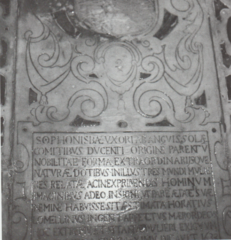
Sofonisba Anguissola’s grave on the floor of San Giorgio dei Genovese in Palermo, Sicily (Italy).
Dedicated in 1632, on what would have been her one-hundredth birthday, the monument is translated to read: To Sofonisba, my wife, whose parents are the noble Anguissola, for beauty and extraordinary gifts of nature, who is recorded among the illustrious women of the world, outstanding in portraying the images of man, so excellent that there was no equal in her age. Orazio Lomellino, in sorrow for the loss of his great love, in 1632, dedicated this little tribute to such a great woman.
ENDNOTES
[1] De la Croix, Horst and Richard G. Tansey, seventh edition, Gardner’s Art through the Ages, (New York: Harcourt, Brace and Jovanovich, 1980). Mannerism is dated from 1520, with the death of Raphael, 556. The Baroque period is dated from the end of the 16th Century, 630.
[2] Perlingieri, 86.
[3]Ropa (Spanish): a loose-fitting, full-length surcoat worn by women.
[4] Zimarra (Italian): a loose-fitting, full-length surcoat worn by women.
[5]Perlingieri, Ilya Sandra, Sofonisba Anguissola, The First Great Woman Artist of the Renaissance, (New York: Rizzoli, 1992).
[6] The first of these dating from about 1554 and the last from about 1610.
[7] Tannahill, Reay, Sex in History, New York, Stein and Day, 1982, 333.
[8] Fun Trivia: A: The Smile Maker: http://www.funtrivia.com/en/subtopics/Sofonisba-Anguissola-The-Smile-Maker-145784.html
[9] “Signs and Symbols Representing God and the Saints”: http://www.catholictradition.org/Saints/signs4.htm
[10] The two children are identified as daughters in the exhibition catalog Master European Paintings from the National Gallery of Ireland (1992). It is my opinion based on the lack of a hair ornament and the apple held in the younger child’s hand, that the child is a boy. It must be noted that boys wore dresses until they were five or six years of age, up to, and including, the early years of the Twentieth Century.
[11] Based on the lack of a hair ornament and the fact that boys wore skirts until they were breeched (begin to wear breeches or pants) between the age of five and six, I believe this child to be a boy.
[12]Deuteronomy 32.10: He found him in a desert land, and in the waste howling wilderness he led him about, instructed him, he kept him as the apple of his eye. King James Bible: http://biblehub.com.
[13] Psalms 17.8: Keep me as the apple of the eye, hide me under the shadow of thy wings. King James Bible: http://biblehub.com
[14] Vasari, Giorgio, Lives of Painters, Sculptors and Architects, Trans. Gaston du C. de Vere. New York: Everyman’s Library, 1996.
[15] Vasari, Giorgio, 466.
[16] Vasari, Giorgio, 468. For most of history, “the woman’s place was in the home” as a wife, child bearer, mother, and homemaker.
[17] Robin, Diana, Anne R. Larsen and Carol Levin, The Encyclopedia of Women in the Renaissance: Italy, France and England, Santa Barbara: ABC-CLIO Books, 2007, 14. The article about Sofonisba Anguissola defines the word “diligenza” as a category of praise commonly awarded to women.
[18]Perlingieri, Paintings by Sofonisba have been wrongly attributed to Alonso Sanchez Coello and Pantoja de la Cruz and vice versa, 123- 135.
[19]Salomon, Xavier F., Van Dyck in Sicily: 1624- 1625 Painting and the Plague, (Milan: Silvana Editoriale Spa, 2012), 72.
[20] Salomon, 72.
[21]Perlingieri, 67.
[22]Perlingieri, 204.
[23]Perlingieri, 207.
[24]Perlingieri, 138, 151, 171.
[25]Perlingieri, 197.
[26] Perlingieri, 170, 210. A marble slab covers Sofie’s floor-level tomb in her parish church, San Giorgio dei Genovesi, in Palermo Sicily. Dedicated in 1632, on what would have been her one-hundredth birthday, the monument reads: To Sofonisba, my wife, whose parents are the noble Anguissola, for beauty and extraordinary gifts of nature, who is recorded among the illustrious women of the world, outstanding in portraying the images of man, so excellent that there was no equal in her age. Orazio Lomellino, in sorrow for the loss of his great love, in 1632, dedicated this little tribute to such a great woman.